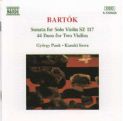Best Of Bartok (Naxos Audio CD)
Best Of Bartok (Naxos Audio CD)
* Estimated price converted from UK retail price
The Hungarian composer Béla Bartók was born in 1881 in a region that now forms part of Romania. His father, director of an agricultural college, was a keen amateur musician, while it was from his mother that he received his early piano lessons. The death of his father in 1889 led to a less settled existence, as his mother returned to work as a teacher, eventually making her home in Pozsony, the modern Bratislava, where Bart6k passed his early adolescence, counting among his school-fellows the composer Ernö Dohnányi. Offered the chance of musical training in Vienna, like Dohnányi he chose instead Budapest, where he won a considerable reputation as a pianist, being appointed to the teaching staff of the Academy of Music in 1907. At the same time he developed a deep interest, shared with his compatriot Zoltán Kodály, in the folk-music of his own and adjacent countries, later extended as far as Anatolia, where he collaborated with the Turkish composer Adnan Saygün.
As a composer Bartók found acceptance much more difficult, particularly in his own country, which was, in any case, beset by political troubles, when the brief post-war left-wing government of Béla Kun was replaced by the reactionary régime of Admiral Horthy. Meanwhile his reputation abroad grew, particularly among those with an interest in contemporary music, and his success both as a pianist and as a composer, coupled with dissatisfaction at the growing association between the Horthy government and National Socialist Gennany, led him in 1940 to emigrate to the United States of America.
In his last years, after briefly holding teaching positions at Columbia and Harvard, Bartók suffered from increasing ill-health and from poverty which the conditions of exile in war-time could do nothing to alleviate. He died in straitened circumstances in 1945, leaving a new Viola Concerto incomplete and a Third Piano Concerto more nearly finished. Bartók's Romanian Folk Dances, a reflection of his interest in folk-music and his great ability in using such melodic material so as to set it off in a new way, was conceived in 1915 for piano and is now equally well known in an arrangement for violin and piano and for solo violin and string orchestra. The short dances are Stick Dance, Sash Dance, In One Place, Horn Dance, Romanian Polka and a final rapid Maruntel.
Bartók dedicated his Second Violin Concerto, completed in 1938, to the violinist Zoltán Székely, for many years leader of the Hungarian String Quartet. The slow movement is one of great beauty and tenderness, with a theme that is freely varied in the following six sections. The first of these has the soloist accompanied by timpani and double bass, the second expands the thematic material with intervention from the harp, the third introduces emphatic chords for the solo violin, the fourth includes a canon in which the soloist is shadowed by other string instruments, the fifth is a capricious scherzo, while the sixth moves finally to a lyrical mood, with an element of canonic imitation. The work was given its first performance in Amsterdam in 1938 with Székely and the Concertgebouw Orchestra undet Willem Mengelberg.
The Allegro barbaro of 1911 is a thoroughly Hungarian work, derived from Magyar folk material, its mood aptly embodied in its title.
In the United States Bartók had support from a number of musicians resident there. The violinist Yehudi Mein was among those who provided help in the form of a commission for a sonata for unaccompanied violin. The Solo Violin Sonata was completed in 1944 and Menuhin gave the first performance in New York in November of the same year. This taxing work, with its seeming debt to Bach, at least at the outset, is in four movements, the third of which, Melodia, is in ternary form, outer sections framing a contrasted middle section, but makes much use of variation. As a result of this the derivation of the third section from the first may not be immediately apparent to a listener.
Bartok's Concerto for Orchestra represents another commission during his final years in the United States, this time from Serge Koussevitzky, who conducted the first performance in Boston in December 1944 with the Boston Symphony Orchestra. It remains one of the composer's most widely known compositions. The fourth of the five movements, Intermezzo interrotto, includes raucous interruptions from the brass after the intrusion of a reference to Shostakovich, here satirised, while the general melodic material has a folk contour to it, with its asymmetrical Bulgarian rhythms.
At his death Bartók left two important works unfinished. The first of these, the Third Piano Concerto, was the principal object of his attention during his last illness and was completed by his friend, the viola-player and composer Tibor Serly, to be given its first performance in February 1946 by the Hungarian pianist György Sándor with the Philadelphia Orchestra under Eugene Ormandy. The second movement, marked Andante religoso, starts with a chorale-like theme and there is a central night-music section, with answering bird-calls, before the woodwind instruments bring back the chorale, to which the piano makes its own addition.
Contrasts was written in 1938 in response to a commission from the American jazz clarinettist Benny Goodman, suggested by the Hungarian-born violinist Joseph Szigeti, also resident in the United States. The outer movements were first performed by Goodman, Szigeti and Endre Petri in New York in January 1939 and the whole work was later recorded by Goodman, Szigeti and Bartók. Originally designed as a two-movement rhapsody, the central movement was later added. The first movement has the title Verbunkos, the Hungarian recruiting dance, a happier solution to military problems than the press-gang. It is a slow dance and includes a clarinet cadenza.
In 1995 the composer's son, Péter Bartók, with Paul Neubauer, provided a new version of the Viola Concerto, which Bartók was writing for the viola-player William Primrose. Shortly before his death he had written to Primrose assuring him that the work was virtually complete, but the manuscripts he left presented a problem to editors. The first version, known now for half a century, was made by Tibor Serly and first performed by Primrose in Minneapolis in December 1949 with the Minneapolis Symphony Orchestra under Antal Dórati. The second and third movements of the concerto remain characteristic of the composer, now writing in a necessarily translucent texture and, as always, in an idiom essentially derived from his roots in Hungarian folk-music and its rhythms.
The 44 Duos for Two Violins may have been intended as teaching material but can also make attractive recital repertoire. Written in 1931, the duos are based on folk material, characteristically treated. The fourth of the four books starts with the Prelude and Canon here included.
Bartók's Music for Strings, Percussion and Celesta was commissioned by Paul Sacher for the Basle Chamber orchestra, with which he gave the fir
Kazuki Sawa (Violin)
Hong-Mei Xiao (Viola)
Kálmán Berkes (Clarinet)
Jenö Jandó (Piano)
György Pauk (Violin)
Balázs Szokolay (Piano)
Brussels Belgian Radio & TV Philharmonic Orchestra
Budapest Philharmonic Orchestra
Budapest Symphony Orchestra
Polish Radio Symphony Orchestra
Janos Kovács, conductor
András Ligeti, conductor
Alexander Rahbari, conductor
Antoni Wit, conductor







